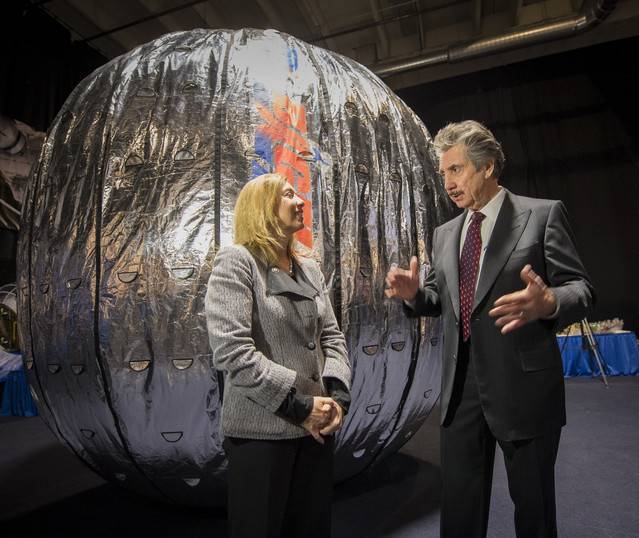Las Vegans are used to seeing passenger planes, fighter jets and helicopters crisscrossing the congested skies.
Next year, if you make the extra effort, you could also see a spacecraft.
Aerospace entrepreneur Robert Bigelow unveiled plans Thursday for a craft known as The Guide. He gave few details but described it as a “flight-like testing unit” that is smaller than a car.
He plans to have test flights in early 2014 at a dry lake near Alamo, about 100 miles north of Las Vegas.
Bigelow, founder and president of North Las Vegas’ Bigelow Aerospace, said The Guide would be able to land as an operational base on the moon. He did not disclose its development costs but said he is “trying to get (it) in contract.” It’s the “simplest, least expensive base” he could build, as NASA looks more and more to the private sector for help with human space missions, Bigelow said.
“We are very serious about this,” he said at a press conference in Washington, D.C., at the National Aeronautics and Space Administration headquarters.
A company spokesman did not return a call seeking more details on the project.
Bigelow was in Washington to discuss a deal he reached in March with NASA to explore how private companies can contribute to missions beyond the area known as “low earth orbit,” about 1,200 miles above sea level.
The two sides are working to determine which companies can contribute to such missions, what expertise they would bring to the table and what types of missions they could work on.
No money will change hands between Bigelow and NASA as part of the study.
NASA typically develops plans for various projects and then asks the private sector to contribute. With the study, agency officials decided to flip that process and ask companies from the get-go where they see business opportunities, said Bill Gerstenmaier, associate administrator of human exploration and operations at NASA.
Bigelow said his company has also talked with officials from space agencies in Japan, the United Arab Emirates and “a few other folks” in the Middle East, all of whom want to ramp up their space exploration.
He and NASA officials must “constantly assure and reassure them” that, despite what they hear and read about NASA’s budget woes, space transportation “will be a reality,” Bigelow said.
President Barack Obama has proposed a $17.7 billion budget for NASA for the fiscal year starting Oct. 1. If the automatic budget cuts known as sequestration remain in place, NASA reportedly would lose almost $1 billion in funding next year.
Bigelow Aerospace, founded in 1999, develops expandable space-habitat technology. The company launched two prototype modules into space in 2006 and 2007 aboard converted Russian intercontinental ballistic missiles. The spacecraft remain orbiting Earth once every 96 minutes.
NASA officials announced in January that they awarded the company a $17.8 million contract to provide a Bigelow Expandable Activity Module, or BEAM, to the International Space Station. The BEAM is an inflatable room that can be compressed into a 7-foot tube.
If it proves durable, it could help lead to space stations on the moon and missions to Mars.
The company has taken part in at least one other test flight near Alamo.
About a year ago, the Boeing Co. completed a parachute test drop of the CST-100 spacecraft, which it developed with help from Bigelow.
According to The Wall Street Journal, the CST-100 can transport up to seven people, and Bigelow plans to use it to ferry people to and from its space modules.
